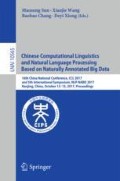Abstract
Recently long short-term memory language model (LSTM LM) has received tremendous interests from both language and speech communities, due to its superiorty on modelling long-term dependency. Moreover, integrating auxiliary information, such as context feature, into the LSTM LM has shown improved performance in perplexity (PPL). However, improper feed of auxiliary information won’t give consistent gain on word error rate (WER) in a large vocabulary continuous speech recognition (LVCSR) task. To solve this problem, a multi-view LSTM LM architecture combining a tagging model is proposed in this paper. Firstly an on-line unidirectional LSTM-RNN is built as a tagging model, which can generate word-synchronized auxiliary feature. Then the auxiliary feature from the tagging model is combined with the word sequence to train a multi-view unidirectional LSTM LM. Different training modes for the tagging model and language model are explored and compared. The new architecture is evaluated on PTB, Fisher English and SMS Chinese data sets, and the results show that not only LM PPL promotion is observed, but also the improvements can be well transferred to WER reduction in ASR-rescore task.
Access this chapter
Tax calculation will be finalised at checkout
Purchases are for personal use only
Notes
References
Katz, S.: Estimation of probabilities from sparse data for the language model component of a speech recognizer. IEEE Trans. Acoust. Speech Signal Process. 35(3), 400–401 (1987)
Mikolov, T., Karafiát, M., Burget, L., Černockỳ, J., Khudanpur, S.: Recurrent neural network based language model. In: INTERSPEECH, Conference of the International Speech Communication Association, Makuhari, Chiba, Japan, September, DBLP, pp. 1045–1048 (2010)
Mikolov, T., Kombrink, S., Burget, L., Černockỳ, J., Khudanpur, S.: Extensions of recurrent neural network language model. In: IEEE International Conference on Acoustics, Speech and Signal Processing (ICASSP), pp. 5528–5531. IEEE (2011)
Hochreiter, S., Schmidhuber, J.: Long short-term memory. Neural Comput. 9(8), 1735–1780 (1997)
Sundermeyer, M., Schlüter, R., Ney, H.: LSTM neural networks for language modeling. In: INTERSPEECH, vol. 31, pp. 194–197 (2012)
Shi, Y., Wiggers, P., Jonker, C.M.: Towards recurrent neural networks language models with linguistic and contextual features. In: INTERSPEECH, vol. 48, pp. 1664–1667 (2012)
Sang, T.K., Erik, F., Buchholz, S.: Introduction to the CoNLL-2000 shared task: chunking. In: The Workshop on Learning Language in Logic and the Conference on Computational Natural Language Learning, pp. 127–132 (2000)
Shi, Y., Larson, M., Pelemans, J., Jonker, C.M., Wambacq, P., Wiggers, P., Demuynck, K.: Integrating meta-information into recurrent neural network language models. Speech Commun. 73, 64–80 (2015)
Collobert, R., Weston, J.: A unified architecture for natural language processing: deep neural networks with multitask learning. In: International Conference on Machine Learning, ICML 2008, pp. 160–167 (2008)
Liu, B., Lane, I.: Joint online spoken language understanding and language modeling with recurrent neural networks. In: IEEE International Conference on Acoustics, Speech and Signal Processing (ICASSP), pp. 160–167 (2016)
Schmid, H.: Part-of-speech tagging with neural networks. In: Proceedings of the 15th Conference on Computational Linguistics, vol. 1, pp. 172–176. Association for Computational Linguistics (1994)
Wang, P., Qian, Y., Soong, F.K., He, L., Zhao, H.: A unified tagging solution: bidirectional LSTM recurrent neural network with word embedding. Comput. Sci. (2015)
Viterbi, A.J.: Error bounds for convolutional codes and an asymptotically optimum decoding algorithm. IEEE Trans. Inf. Theory 13, 260–269 (1967)
Ghahremani, P., Droppo, J.: Self-stabilized deep neural network. In: IEEE International Conference on Acoustics, Speech and Signal Processing, pp. 5450–5454 (2016)
Qi, L., Tian, T., Kai, Y.: An investigation on deep learning with beta stabilizer. In: IEEE International Conference on Signal Processing, pp. 557–561 (2017)
Taylor, A., Marcus, M., Santorini, B.: The penn treebank: an overview. In: Abeillé, A. (ed.) Treebanks. Text, Speech and Language Technology, vol. 20, pp. 5–22. Springer, Netherlands (2003). doi:10.1007/978-94-010-0201-1_1
Stolcke, A., et al.: SRILM-an extensible language modeling toolkit. In: International Conference on Spoken Language Processing, pp. 901–904 (2002)
Toutanova, K., Manning, C.D.: Enriching the knowledge sources used in a maximum entropy part-of-speech tagger. In: Joint Sigdat Conference on Empirical Methods in Natural Language Processing and Very Large Corpora: Held in Conjunction with the Meeting of the Association for Computational Linguistics, pp. 63–70 (2000)
Author information
Authors and Affiliations
Corresponding author
Editor information
Editors and Affiliations
Rights and permissions
Copyright information
© 2017 Springer International Publishing AG
About this paper
Cite this paper
Wu, Y., He, T., Chen, Z., Qian, Y., Yu, K. (2017). Multi-view LSTM Language Model with Word-Synchronized Auxiliary Feature for LVCSR. In: Sun, M., Wang, X., Chang, B., Xiong, D. (eds) Chinese Computational Linguistics and Natural Language Processing Based on Naturally Annotated Big Data. NLP-NABD CCL 2017 2017. Lecture Notes in Computer Science(), vol 10565. Springer, Cham. https://doi.org/10.1007/978-3-319-69005-6_33
Download citation
DOI: https://doi.org/10.1007/978-3-319-69005-6_33
Published:
Publisher Name: Springer, Cham
Print ISBN: 978-3-319-69004-9
Online ISBN: 978-3-319-69005-6
eBook Packages: Computer ScienceComputer Science (R0)

